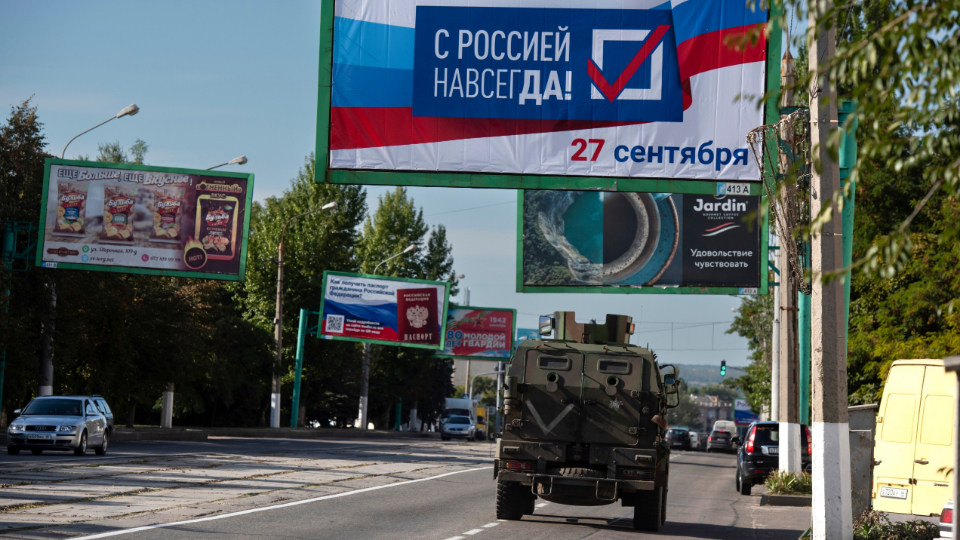
Russia now stands ready to annex the parts of eastern Ukraine that its invading troops currently occupy. Following the announcement of vote totals in the referendums held in the territories controlled by his military, President Vladimir Putin is expected to address the Russian parliament Friday and officially finalize the land grab.
The absorption of the territories, which include but are not limited to Russian ethnic-majority regions that have sought separation from Ukraine for years, comes on the same day that the two major pipelines built to carry natural gas from Russia to Germany exploded beneath the Baltic Sea. The damage done to these key pieces of energy infrastructure are being widely described as an act of sabotage, but confusion reigns as to who might be responsible.
Paired with Putin’s recent declaration of his willingness to use nuclear weapons to defend Russian territory—including, apparently, the conquered Ukrainian lands—the destruction of this essential lifeline for both the Russian economy and European energy security gravely escalates the danger that the Ukraine war could spiral into an even larger conflict.
Votes used to justify nuclear escalation
As predicted, the votes orchestrated by Moscow resulted in overwhelming numbers of people in the regions of Zaporizhzhia, Kherson, Luhansk, and Donetsk supposedly casting ballots to be absorbed by the Russian Federation. Officials in the Ukrainian capital, Kiev, denounced the referendums as illegal and rigged, an expected conclusion given the circumstances in which they were held.

Armed Russian soldiers accompanied election officials collecting ballots at residents’ doorsteps over the course of five days. Conducted in the middle of an armed conflict and in a war zone, the referendums stand no chance of gaining widespread international recognition. The Ukrainian foreign ministry called the balloting a “propaganda show” and said Russia was “forcing people in these territories to fill out some papers at the barrel of a gun.”
Nevertheless, Russian-installed authorities in the regions pushed ahead with declarations that people in eastern Ukraine overwhelmingly desired union with Russia. Counts published by the Russian news agency RIA Novosti claimed a “yes” vote of 93% in Zaporizhzhia, where a nuclear power plant has been repeatedly shelled by both sides; 87% in the devastated city of Kherson; and 98% and 99% respectively in the self-declared “People’s Republics” of Luhansk and Donetsk.
Participation in the referendums was a lose-lose situation for Ukrainians living in the disputed territories. Pressure to vote by occupying Russian forces provided an incentive to cast a ballot that could not be ignored, but the simultaneous threat of retaliation by Ukrainian troops and militia raised fears of reprisals should the regions ever return to Ukrainian control.
Putin has called up 300,000 more reservists and retired military personnel in recent days, and the Russian parliament passed harsh new measures to punish deserters and anyone who refuses military service. Long lines have formed at Russia’s borders with Georgia and other countries as young men attempt to flee conscription. Protesters demonstrating against the war, meanwhile, have faced repression in Moscow and other major cities.
The resort to outright annexation, rather than simply continued economic and military support to the separatist areas, comes as the Russian Army’s offensive in Ukraine appears to have stalled. Taken together, the measures suggest the Russian high command faces major difficulties in continuing its campaign in Ukraine.
The danger of wider escalation was raised, however, by Putin’s recent statement that he stands ready to use nuclear weapons to defend Russian territory. With the Kremlin now considering the annexed eastern regions to be part of Russia, this would allow him to characterize any Ukrainian counteroffensive as an attack on Russia itself.
The U.S. has warned of “catastrophic consequences” if Putin uses nuclear weapons, even while at the same time admitting it does not believe Russia truly has any such intention. National Security Advisor Jake Sullivan said Sunday that the U.S. will “respond decisively” in the event of a nuclear strike against Ukraine.
Given the presence of the U.S.’ own nuclear weapons in several NATO countries in Europe and the stationing of nuclear-capable delivery systems in countries on the Russian border, the situation threatens to spin further out of control and endanger the whole world.
Sabotage under the sea
Meanwhile, the blowing up of the Nord Stream 1 and 2 pipelines beneath the Baltic Sea injects more volatility into the mix. Built jointly by Russia and Germany to deliver natural gas to central Europe, the two pipelines have been a major, if often little-discussed, factor in the Ukraine conflict.
Confusion reigns and accusations are swirling as to who could be responsible for the detonations that crippled both lines, with multiple countries having motives. As methane continues to billow from the ruptured pipes, a closer investigation remains impossible for the time being.
Kremlin spokesperson Dmitri Peskov said the incident “looks like some kind of terrorist attack, possibly at the state level.” NATO on Thursday formally declared it an act of sabotage, with ambassadors saying, “Any deliberate attack against Allies’ critical infrastructure” would be met with a “united and determined response.”

Member state Poland, which just opened its own new pipeline to get gas from Norway the day before the explosions, immediately blamed Russia; the Ukrainian government did the same.
Forbes, one of the main outlets of the U.S. business class, joined them. In an article published Thursday morning, the magazine alleged that Russia was determined to strangle Europe ahead of winter while dodging its own contractual obligations to deliver energy. It echoed the analysis of many commentators who said Russia was out to squeeze Europe into accepting the current lines of demarcation in eastern Ukraine as permanent borders.
Without evidence, Forbes claimed the pipeline attacks were also an effort by Putin to lock in domestic support by giving oligarchs no outside sources of income. Writer Ariel Cohen claimed: “Russia’s economy is faltering, its military is sub-par, and Putin’s grip on power may weaken in months, if not weeks.”
A number of officials in Washington and European capitals tried to slow the rush to blame Moscow on Wednesday, however. It was pointed out that the Russian company Gazprom spent billions to build the pipelines and would likely hope to resume shipments through them when hostilities someday end in Ukraine and relations are repaired with Europe. The damage to Russia’s economy from these explosions could be just as significant as that caused to European countries.
According to the New York Times, U.S. officials and experts on Eastern Europe even speculated that Ukraine or one of the Baltic states—Lithuania, Latvia, or Estonia—which have long opposed the pipelines, might have tried to destroy them. All these countries saw their revenues as middlemen for the land-based transport of Russian energy threatened by the direct link between Russia and Germany.
A number of critics of U.S. foreign policy wondered whether Washington could have had a hand in the explosions. U.S. fracked gas companies’ sales to Europe were flat, with little hope of growth, before the Ukraine war; Nord Stream represented a permanent block on their plans to expand their position in the continent’s energy markets.
Some reports point to statements by President Joe Biden in February in which he declared, “There will no longer be a Nord Stream 2” if Russia invaded Ukraine. “We will bring an end to it,” Biden said. When asked by journalists how the U.S. would do that, since it was a German-Russian joint venture, he responded, “I promise you, we’ll be able to do it.”
Regardless of who is responsible for the pipeline attack, it is sure to send Europe into recession, cause energy prices and inflation to soar further, and deny Russia future gas sales. The economic fallout will hit many of the actors in this conflict, but it will also leave openings for increased profits to others.
Back to Minsk?
With the Russian military facing major challenges, the referendums and nuclear threats could be part of a strategy by Putin to permanently cement the status quo when it comes to territorial acquisitions and military positions. If the costs of continued war become too high for all involved, his calculation may be that the U.S. will slow arms shipments to Ukraine, Kiev will halt attempts to recover its territory, and plans for NATO expansion will be shelved to avoid further danger.
It’s not a result that either Ukraine or its backers in the U.S. or Europe would be eager to accept, nor would it mesh with long-term NATO strategy of encircling and containing Russia.

Regardless, the fallout from the destruction of the Nord Stream pipelines could sink that possible outcome anyway. The trading of accusations further inflates tensions, especially between NATO and Russia, and Western multinational energy corporations look set to be the initial beneficiaries. They—along with weapons dealers—have profited immensely these last seven months and will undoubtedly see their revenues grow fatter.
A ceasefire and negotiations between Ukraine and Russia—and ultimately talks between the U.S. and Russia—remain the only actions likely to truly defuse the danger that this war could explode into a wider global conflict.
The Minsk Accords of 2015—which would have continued economic cooperation between Russia and Europe, allowed autonomy for the eastern regions of Ukraine but maintained the country’s integrity and independence, and provided security guarantees by preventing NATO expansion—could have prevented the current war.
They were never implemented though, and after seven months of the Russian invasion, thousands upon thousands of people are dead who didn’t have to die, economic ties have been needlessly but perhaps permanently ruptured, tons of methane have been dumped into the atmosphere from beneath the sea, and billions of dollars have been wasted on all sides which could have gone to public needs.
The question now: Is there any way back to Minsk? Talks are the only path that will ever lead to peace.

MOST POPULAR TODAY

Zionist organizations leading campaign to stop ceasefire resolutions in D.C. area

High Court essentially bans demonstrations, freedom of assembly in Deep South

UN warns that Israel is still blocking humanitarian aid to Gaza

Communist Karol Cariola elected president of Chile’s legislature

U.S. imperialism’s ‘ironclad’ support for Israel increases fascist danger at home






Comments